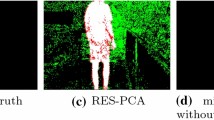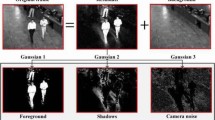Abstract
Background subtraction is one of the key technologies for recognizing and detecting moving targets in the field of video surveillance. To cope with the dynamic background and slow moving objects, a new background subtraction model with logarithm rank function and structured sparsity was proposed based on Robust Principal Component Analysis (RPCA). In this model, the segmentation and index trees were used to dynamically process the foreground, enhancing the appearance similarity and spatial continuity between the pixels. Then, C(2,1) norm was applied to constrain the sparsity of the image block and to strengthen the structured sparsity of foreground. Finally, the background was constrained by the logarithm rank function, which adaptively scaled the weight of large singular values and considered the influence of different singular values on the rank function. The experimental results show that, compared to the state-of-the-art algorithms, 90% of the F-measure values of the proposed model are the best and 10% are the second best. In addition, our new approach exhibits superior performance in subjective evaluation, particularly in dynamic backgrounds, slow moving targets and camera jitter.









Similar content being viewed by others
References
Airport Ground Video Surveillance (AGVS). [Online]. Available: http://www.agvs-caac.com/index.html
Bouwmans T, Zahzah E H (2014) Robust PCA via principal component pursuit: a review for a comparative evaluation in video surveillance. Comput Vis Image Underst 122(122):22–34
Cai S, Luo Q, Yang M, Li W, Xiao M (2019) Tensor robust principal component analysis via non-convex low rank approximation. Appl Sci 9 (7):1411
Candes E J, Li X, Ma Y, John W (2011) Robust principal component analysis?. J ACM 58(30):233–279
Cao W, Wang Y, Sun J, Meng D, Yang C (2016) Total variation regularized tensor RPCA for background subtraction from compressive measurements. IEEE Trans Image Process 25(9):4075–4090
Cao X, Yang L, Guo X (2016) Total variation regularized RPCA for irregularly moving object detection under dynamic background. IEEE sTrans Syst Man Cybern 46(4):1014–1027
Cheng M, Wang C, Wu H (2006) Real-time detection of slow moving and temporarily stationary objects. In: 2006 IEEE International Conference on Systems, Man and Cybernetics. IEEE, pp 3983–3988
Deng W, Yin W (2016) On the global and linear convergence of the generalized alternating direction method of multipliers. J Sci Comput 66(3):889–916
Ebadi S E, Izquierdo E (2018) Foreground segmentation with tree-structured sparse RPCA. IEEE Trans Pattern Anal Mach Intell 40(9):2273–2280
Friedman N, Russell S (1997) Image segmentation in video sequences: a probabilistic approach. In: Uncertainty in Artificial Intelligence. ArXiv, pp 175–181
Goldfarb D, Qin Z (2014) Robust low-rank tensor recovery: models and algorithms. SIAM J Matrix Anal Appl 35(1):225–253
Jenatton R, Mairal J, Obozinski G, Bach F (2011) Proximal methods for hierarchical sparse coding. J Mach Learn Res 12(12):2297–2334
Li L, Huang W, Gu Y H, Tian Q (2004) Statistical modeling of complex backgrounds for foreground object detection. IEEE Trans Image Process 11(13):1459–1472
Li Y, Liu G, Chen S (2017) Detection of moving object in dynamic background using Gaussian max-pooling and segmentation constrained RPCA. Computer Vision and Pattern Recognition
Li Y, Zhao Q, Feng X, Wang W, Yan A (2019) A variational image segmentation method exploring both intensity means and texture patterns. Signal Process Image Commun 76:214–230
Liu J, Ye J (2010) Moreau-Yosida regularization for grouped tree structure learning. In: Neural Information Processing Systems, pp 1459–1467
Lu C, Feng J, Chen Y, Liu W, Lin Z, Yan S (2020) Tensor robust principal component analysis with a new tensor nuclear norm. IEEE Trans Pattern Anal Mach Intell 42(4):925–938
Mahadevan V, Vasconcelos N (2008) Background subtraction in highly dynamic scenes. In: 2008 IEEE Computer Society Conference on Computer Vision and Pattern Recognition. IEEE, pp 1–6
Monnet A, Mittal A, Paragios N, Ramesh V (2003) Background modeling and subtraction of dynamic scenes. In: 2003 IEEE International Conference on Computer Vision. IEEE, pp 1305–1312
Peng H, Bing L, Ling H, Hu W, Maybank S J (2017) Salient object detection via structured matrix decomposition. IEEE Trans Pattern Anal Mach Intell 39(4):818–832
Rezaei B, Ostadabbas S (2017) Background subtraction via fast robust matrix completion. In: IEEE Computer Society. IEEE, pp 1871–1879
Tom AJ, George SN (2018) Tensor total variation regularized moving object detection for surveillance videos. In: 2018 International Conference on Signal Processing and Communications (SPCOM). IEEE, pp 327–331
Wang M, Liu X, Gao Y, Ma X, Soomro N Q (2017) Superpixel segmentation: a benchmark. Signal Process Image Commun 56:28–39
Wang Y, Yin W, Zeng J (2019) Global convergence of ADMM in nonconvex nonsmooth optimization. J Sci Comput 78(1):29–63
Xie Q, Zhao Q, Meng D, Xu Z (2018) Kronecker-basis-representation based tensor sparsity and its applications to tensor recovery. IEEE Trans Pattern Anal Mach Intell 40(8):1888–1902
Xu J, Ding X, Wang S, Wu Y (2009) Background subtraction based on a combination of local texture and color. Acta Autom Sin 35(9):1145–1150
Xue J, Zhao B, Liao W, Chan C (2019) Nonconvex tensor rank minimization and its applications to tensor recovery. Inf Sci 503:109–128
Yang J, Liu G, Liu Q, Li K, Hou C (2020) Spatiotemporally scalable matrix recovery for background modeling and moving object detection. Signal Process 168:1–13
Yang L, Liu G, Liu Q, Sun Y, Chen S (2019) Moving object detection via segmentation and saliency constrained RPCA. Neurocomputing 323:352–362
Yi W, Jodoin PM, Porikli F, Konrad J, Ishwar P (2014) CDnet 2014: an expanded change detection benchmark dataset. In: 2014 IEEE Computer Vision and Pattern Recognition. IEEE, pp 393–400
Yuan M, Lin Y (2006) Model selection and estimation in regression with grouped variables. R Stat Soc Ser B (Statis Methodol) 68(1):49–67
Zheng J, Feng D, Zhang Y, Siu W, Zhao R (2002) An algorithm for video monitoring under a slow moving background. In: 2002 International Conference on Machine Learning and Cybernetics. IEEE, pp 1626–1629
Zhou X, Yang C, Zhao H, Yu W (2015) Low-rank modeling and its applications in image analysis. ACM Comput Surv 47(2):1–36
Acknowledgements
This project is partially supported by the National Natural Science Foundation of China (11961010, 61941111), National Natural Science Foundation of Guangxi Province (2018GXNSFAA138169).
Author information
Authors and Affiliations
Corresponding author
Ethics declarations
Conflicts of Interests
The authors declare that the research was conducted in the absence of any commercial or financial relationships that could be construed as a potential conflict of interest.
Additional information
Publisher’s note
Springer Nature remains neutral with regard to jurisdictional claims in published maps and institutional affiliations.
Rights and permissions
About this article
Cite this article
Ban, Y., Chen, L. & Wang, X. Background subtraction based on logarithm rank function and structured sparsity. Multimed Tools Appl 81, 20465–20481 (2022). https://doi.org/10.1007/s11042-022-11916-1
Received:
Revised:
Accepted:
Published:
Issue Date:
DOI: https://doi.org/10.1007/s11042-022-11916-1




